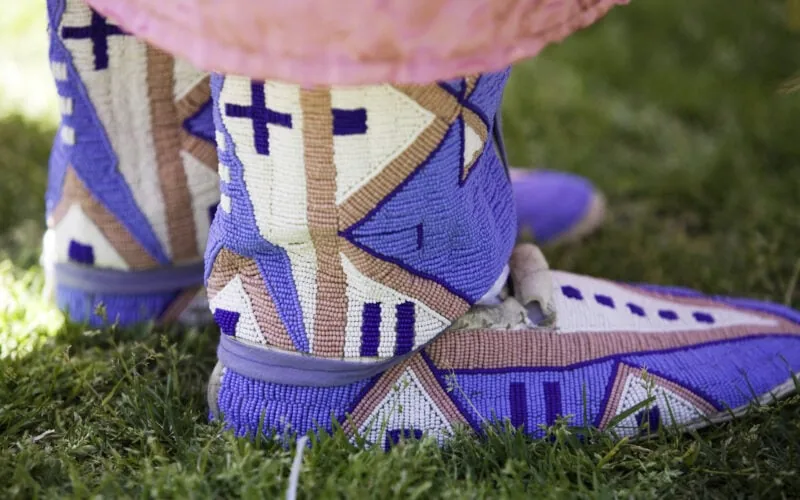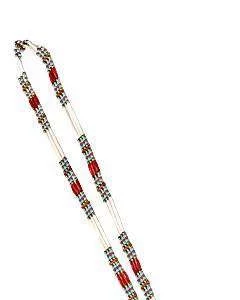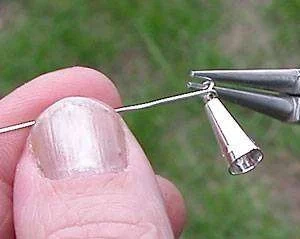Native Americans are famous for their rich cultural heritage, which includes unique craftsmanship and vibrant artistry. Native American beads hold a significant place among their many unique crafts. These beads aren't just decorative items but carry a profound cultural and symbolic meaning.
The early beadwork in Native American tribes was based on the tribe's customs and beliefs.
However, with time, the Native beadwork was influenced by trade, colonization, and interaction with other cultures.
Early History of Native American Beads
Long before Europeans arrived in America, Native Americans had been making beads, and it was an important part of their culture. The Natives used various materials such as shells, stones, bones, seeds, and natural fibers to create them.
Quills, like porcupine quills, were also utilized in designs. In some Native American tribes, designing or fashioning the beads was considered a sacred act entrusted to only a selected few individuals. In other tribes, beadwork was exclusively done by women.
There were various methods that helped Natives in bead creation. They used an old-fashioned stone drill bit pumped by hand to create holes in the bead so it could easily be strung. However, an awl served that purpose as well. Since beads were handmade, it was time-consuming even to create one. The beads were larger and best used to make jewelry and other ornaments.
European Influence on Native American Beads
The Native American Beads were revolutionized due to the introduction of glass and ceramic beads by Europeans in the 16th century. The European people realized that beads were of great importance to Native Americans. Therefore, they heavily used them for gifting and trading purposes.
They treated beads as currency and offered Natives in exchange for goods and services. Most of these beads were from Venice, and some were from Holland. Europeans also brought beads from countries like Czechoslovakia and Poland, which also got the attention of Natives.
Different Native American Trade Beads
Venetian Trade Beads
First on our list are Venetian Trade Beads or, you can say, Venetian Millefiori beads. The “Mille” refers to a thousand, while the “Fiori” means flowers. This name is given due to the intricate multi-layered mosaic design of these Venetian beads. They were produced in 1800 in Murano, Venice, by a method called Winding.
Each bead was created by extracting a molten glass glob from the furnace and winding it around an iron rod. Once the bead was made, it went into the designing process, where a glass of another color was added to it, or various design patterns were made. These patterns were made by adding molten glass into various coloring agents.
For instance, cobalt was used for a blue color, copper for green, tin for a cloudy white, and gold for red. In addition to this method, the Venetians used another method – Blown Glass. The molten glass was removed from the furnace; it went through a glass tube to achieve the desired bead shape.
Padre Beads
Another type of Native American trade beads is Padre Beads, which were first used in the 16th to 18th centuries. These beads were imported from Spain by monks and traders who used them as currency. They were worn by Spanish “Padres” or, you can say, Church Father. That’s why these are named Padre Beads.
It was quite easy to identify the original Padre Beads as they were characterized by their opaque appearance, typically in a sky-blue or turquoise hue. Nonetheless, African Bea's Traders labeled all similar opaque turquoise-blue glass beads as Padres Beads, despite their origin. This resulted in Padre beads of various sizes, colors, and styles that were quickly adopted and became part of the Native American Beads.
Uses of Native American Beads
Now that you know the history and types of native and traded beads, it's time to see how Native Americans used them. Natives used beads in various stitching patterns like lane stitching or loom beading to create multiple things. Some of the prominent uses of Native American beadworks are:
- Ceremonial Regalia Clothing and Accessories: Beads were used to make regalia and accessories that Natives wore during dances and events. These beads symbolized spiritual beliefs, tribal affiliations, and personal status within the community.
- Trade Agreements: Ever since Europeans found the importance of beads for Native Americans, they have used them as a currency for trade. The beads, especially those featuring unique designs, were valuable commodities exchanged for goods and services.
- Treaties: You may not know this, but beads were also useful in treaties. They were used as diplomatic gifts or tokens of goodwill during a treaty negotiation. The purpose of using beads was to express friendship, trust, and alliance with the other party.
- Everyday Embellishments: Besides serving at ceremonies, beads were also used in everyday embellishments. Natives utilized the Native American Beads for decorating items such as clothing, moccasins, bags, and other household items.
Native American Beads hold a significant cultural and spiritual value for Native Tribes. The Native Americans made beads using bone, stones, porcupine quills, shells, and more.
However, in the 16th century, Europeans introduced glass and ceramic beads to the Natives. They used these beads as a currency to get various goods from the Native Americans.




